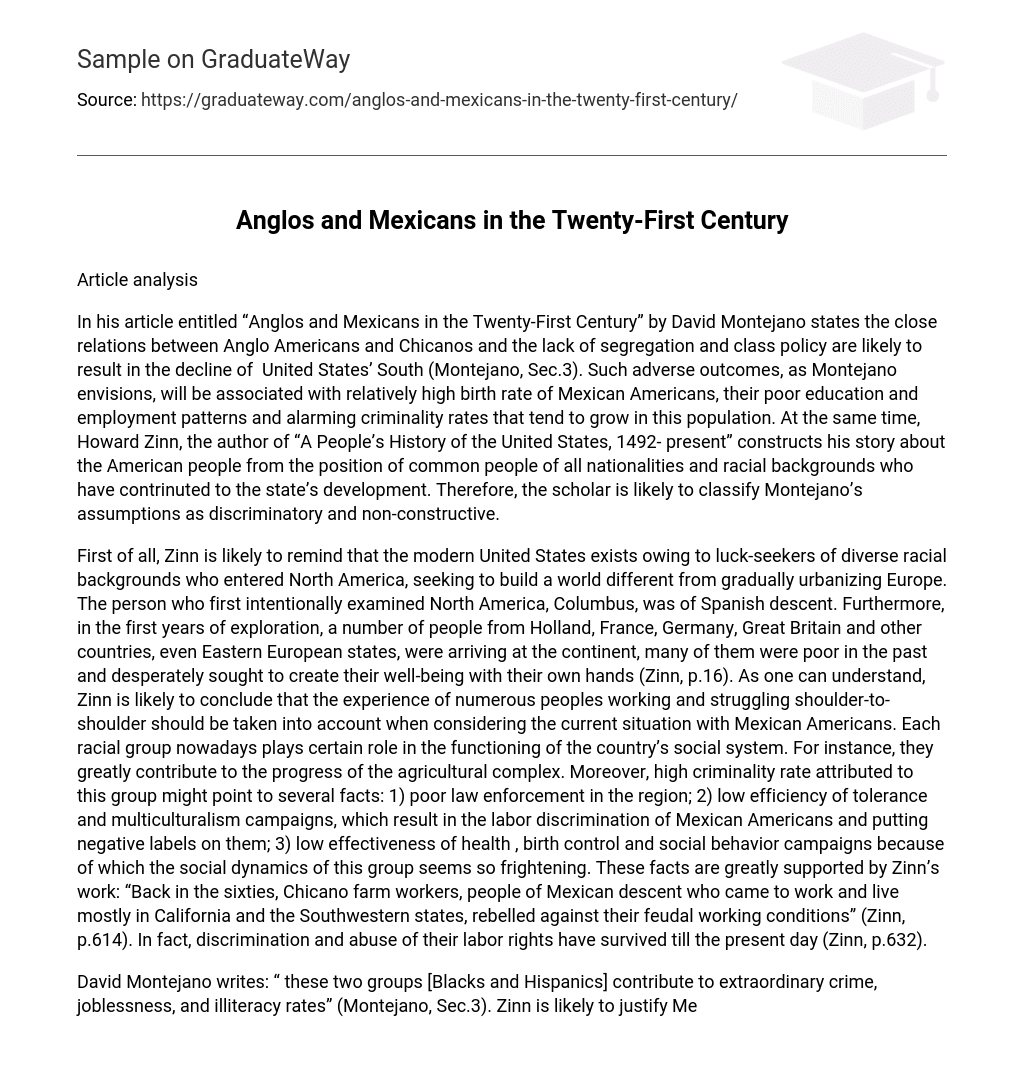In his article entitled “Anglos and Mexicans in the Twenty-First Century” by David Montejano states the close relations between Anglo Americans and Chicanos and the lack of segregation and class policy are likely to result in the decline of United States’ South (Montejano, Sec.3). Such adverse outcomes, as Montejano envisions, will be associated with relatively high birth rate of Mexican Americans, their poor education and employment patterns and alarming criminality rates that tend to grow in this population.
At the same time, Howard Zinn, the author of “A People’s History of the United States, 1492- present” constructs his story about the American people from the position of common people of all nationalities and racial backgrounds who have contrinuted to the state’s development. Therefore, the scholar is likely to classify Montejano’s assumptions as discriminatory and non-constructive.
First of all, Zinn is likely to remind that the modern United States exists owing to luck-seekers of diverse racial backgrounds who entered North America, seeking to build a world different from gradually urbanizing Europe. The person who first intentionally examined North America, Columbus, was of Spanish descent. Furthermore, in the first years of exploration, a number of people from Holland, France, Germany, Great Britain and other countries, even Eastern European states, were arriving at the continent, many of them were poor in the past and desperately sought to create their well-being with their own hands (Zinn, p.16).
As one can understand, Zinn is likely to conclude that the experience of numerous peoples working and struggling shoulder-to-shoulder should be taken into account when considering the current situation with Mexican Americans. Each racial group nowadays plays certain role in the functioning of the country’s social system. For instance, they greatly contribute to the progress of the agricultural complex. Moreover, high criminality rate attributed to this group might point to several facts:
- poor law enforcement in the region;
- low efficiency of tolerance and multiculturalism campaigns, which result in the labor discrimination of Mexican Americans and putting negative labels on them;
- low effectiveness of health , birth control and social behavior campaigns because of which the social dynamics of this group seems so frightening.
These facts are greatly supported by Zinn’s work: “Back in the sixties, Chicano farm workers, people of Mexican descent who came to work and live mostly in California and the Southwestern states, rebelled against their feudal working conditions” (Zinn, p.614). In fact, discrimination and abuse of their labor rights have survived till the present day (Zinn, p.632).
David Montejano writes: “ these two groups [Blacks and Hispanics] contribute to extraordinary crime, joblessness, and illiteracy rates” (Montejano, Sec.3). Zinn is likely to justify Mexican Americans by stating that the history of their stay in the United States has not been as cloudless as Montejano describes it. In fact, they had suffered considerable social rejection as “potential criminals” till the late 1970s and were prevented from getting appropriate education and worthier employment. Nowadays, as their legal rights are protected, they are still encountering social stigma.
Moreover, it needs to be noted that the demand in agricultural workers has fallen substantially over the last forty years and continues to fall, so high unemployment rates in the South are generally explainable. Therefore, Zinn as a defender of multiculturalism and peaceful, constructive coexistence of races, is likely to suggest that the situation can be improved by encouraging Hispanic Americans to gain education and making professional and academic training more affordable.
Education is nowadays designed in accordance with the needs of the Anglo American middle class, so it is necessary to establish human service agensies which would support and accompany Hispanic American youngsters on their path to knowledge and prevent them from experiencing the hardships which their parents faced.
As one can conclude, Zinn is likely to reject Montejano’s thesis about the destructive effect of Mexican American population on the U.S. economy and recommend that this group be better integrated into the society in terms of equal opportunity in education, employment and social services.
Works cited
- Montejano, D. “Anglos and Mexicans in the Twenty-First Century”. August 1992 http://www.jsri.msu.edu/RandS/research/ops/oc03.html
- Zinn, H. A People’s History of the United States, 1492- present. Pearson Education, 2003.





